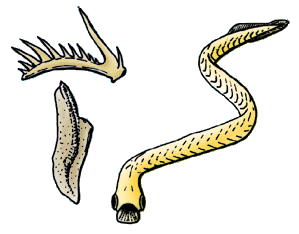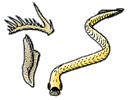Euconodonta
Philippe Janvier
Introduction
Euconodonts have long been an enigmatic group of fossil marine animals, represented by minute, comb-shaped or claw-shaped denticles - the 'conodonts' - which were widely used by stratigraphers for dating and correlating geological formations. They are known from the Middle Cambrian (540 million years) to the Late Triassic (230 million years). These denticles, which are made of calcium phosphate, like the vertebrate bones and teeth, have been variously referred to annelids, arthropods, molluscs, chaetognaths, and even plants, although it has been sometimes suggested that they were fish teeth. The clue came in 1983 when the first articulated "conodont animal" was discovered in the Carboniferous of Scotland. Later, yet another "conodont animal" was found in the Ordovician of South Africa. Both forms show an elongated body, with imprints of chevron-shaped muscles, a trace of the notochord, large paired eyes, and a caudal fin strengthened by radials. The conodont organs (i.e. the denticles) are situated in the head, presumably at the entrance of the pharynx. Recent histological studies on the euconodonts have brought to light a variety of hard tissues which recall the enamel, dentine and bone of the vertebrates, but their homology with vertebrate tissues remains controversial.
Characteristics
Euconodonts are characterized by:
- a feeding apparatus which generally consists of three or four types of mineralized denticles. The denticles have a crown of superficial, lamellar, enamel-like tissue which covers a core of dentine- or bone-like tissue (the 'white matter'). These two tissues overlay a third type of tissue, the 'basal body', which has been interpreted as globular calcified cartilage.
- very large, anteriorly-placed eyes
Discussion of Phylogenetic Relationships
The undoubted presence of well-developed eyes and caudal fin radials in euconodonts are enough to place them among the Craniata, although there position within the craniates is the subject of controversies. Some consider them as the sister-group of all other craniates, others regard them as more closely related to either hagfishes or lampreys, and others place them as the sister-group of all "ostracoderms" + gnathostomes, sharing with them the ability to produce a phosphatic exoskeleton (see Vertebrata page).
The Euconodonta are classically gathered with two other taxa, the Protoconodonta and Paraconodonta, in the phylum Conodonta, despite quite different histological structures. To date, only articulated specimens of the Euconodonta are known, and it is not ruled out that the two other groups have nothing to do with the latter. There is some evidence, for example, that the Protoconodonta are related to modern chaetognaths. There are several classifications of the Euconodonta, but most of them are largely phenetic. They usually include seven orders, the Proconodonta, Belodellida, Protopanderodontida, Panderodontida, Prionodontida, Prioniodinida, and Ozarkodinida.
References
Aldridge, R. J. and Smith, M. P. (1993). Conodonta. Pp 561-570. In The Fossil Record 2 (M. J. Benton, ed.), Chapman and Hall, London, 845 p.
Aldridge, R. J., Briggs, D. E. G., Smith, M. P., Clarkson, E. N. K., and Clark, N. D. L. (1993). The anatomy of conodonts. Philosophical Transactions of the Royal Society of London, B, 340, 405-421.
Aldridge, R. J., Briggs, D. E. G., Clarkson, E. N. K., and Smith, M. P. (1986). The affinities of conodonts - new evidence from the Carboniferous of edinburgh, Scotland. Lethaia, 19, 279-291.
Briggs, D. E. G. (1992). Conodonts: A major extinct group added to the vertebrates. Science, 256, 1285-1286.
Briggs, D. E. G., Clarkson, E. N. K., and Aldridge, R. J. (1983). The conodont animal. Lethaia, 20, 1-14.
Krejsa, R. J., Bringas, P., and Slavkin, H. (1990). A neontological interpretation of conodont elements based on agnathan cyclostome tooth structure, function, and development. Lethaia, 23, 359-378.
Sansom, I. J., Smith, M. P., Armstrong, H. A., Smith, M. M. (1992). Presence of the earliest vertebrate hard tissues in conodonts. Science, 256, 1308-1311.
Sansom, I. J., Smith, M. P. and Smith, M. M. (1994). Dentine in conodonts. Nature, 368, 591.
Schultze, H.-P. (1996). Conodont histology: an indicator of vertebrate relationships? Modern Geology, 20, 275-285.
Sweet, W. C. (1988). The Conodonta: morphology, taxonomy, palaeoecology, and evolutionary history of a long-extinct animal phylum. Oxford Monographs on Geology and Geophysics, 10, Oxford University Press, Oxford and New York.
Title Illustrations

| Scientific Name | Conodonta |
|---|---|
| Comments | The inclusion of euconodonts in the vertebrates, or even craniates, is still controversial. Admittedly, the tissue structure of the "conodonts" (i.e; the denticles situated in their mouth; left) is at odds with conventional vertebrate hard tissues. Nevertheless, the eyes, body shape, and tail stucture of the euconodonta are strikingly vertebrate-like. |
| Reference | After Purnell et al. 1995 |
| Image Use |
 This media file is licensed under the Creative Commons Attribution License - Version 3.0. This media file is licensed under the Creative Commons Attribution License - Version 3.0.
|
| Copyright |
© 1997
Philippe Janvier

|
About This Page
Philippe Janvier

Muséum National d'Histoire Naturelle Paris, France
Page copyright © 1997 Philippe Janvier
 Page: Tree of Life
Euconodonta.
Authored by
Philippe Janvier.
The TEXT of this page is licensed under the
Creative Commons Attribution License - Version 3.0. Note that images and other media
featured on this page are each governed by their own license, and they may or may not be available
for reuse. Click on an image or a media link to access the media data window, which provides the
relevant licensing information. For the general terms and conditions of ToL material reuse and
redistribution, please see the Tree of Life Copyright
Policies.
Page: Tree of Life
Euconodonta.
Authored by
Philippe Janvier.
The TEXT of this page is licensed under the
Creative Commons Attribution License - Version 3.0. Note that images and other media
featured on this page are each governed by their own license, and they may or may not be available
for reuse. Click on an image or a media link to access the media data window, which provides the
relevant licensing information. For the general terms and conditions of ToL material reuse and
redistribution, please see the Tree of Life Copyright
Policies.
Citing this page:
Janvier, Philippe. 1997. Euconodonta. Version 01 January 1997 (under construction). http://tolweb.org/Euconodonta/14832/1997.01.01 in The Tree of Life Web Project, http://tolweb.org/








 Go to quick links
Go to quick search
Go to navigation for this section of the ToL site
Go to detailed links for the ToL site
Go to quick links
Go to quick search
Go to navigation for this section of the ToL site
Go to detailed links for the ToL site